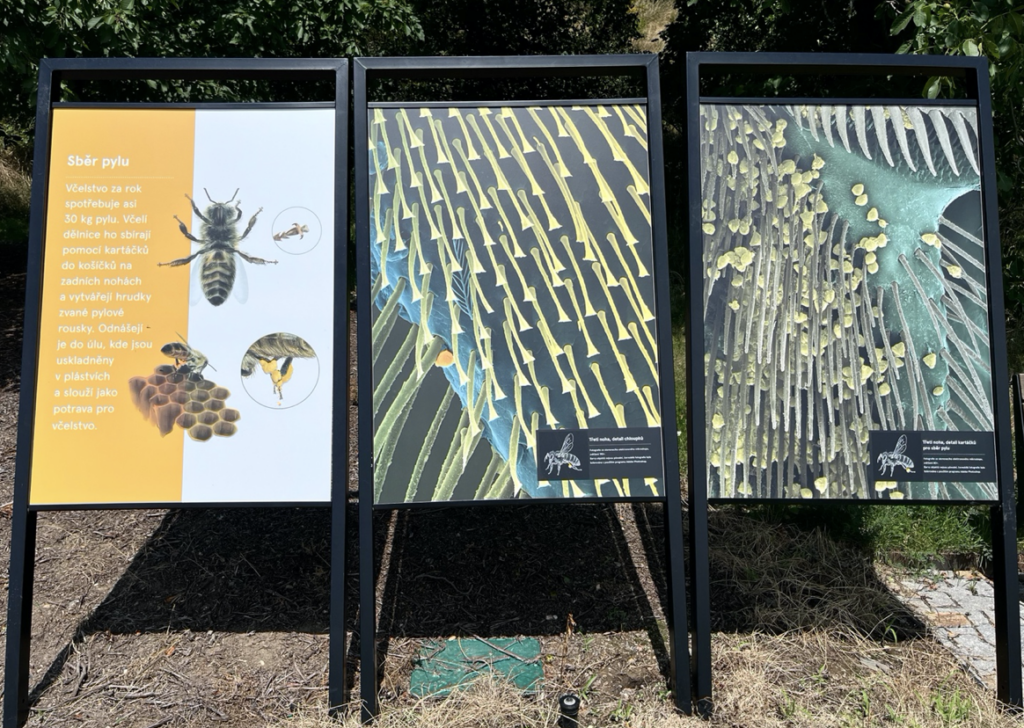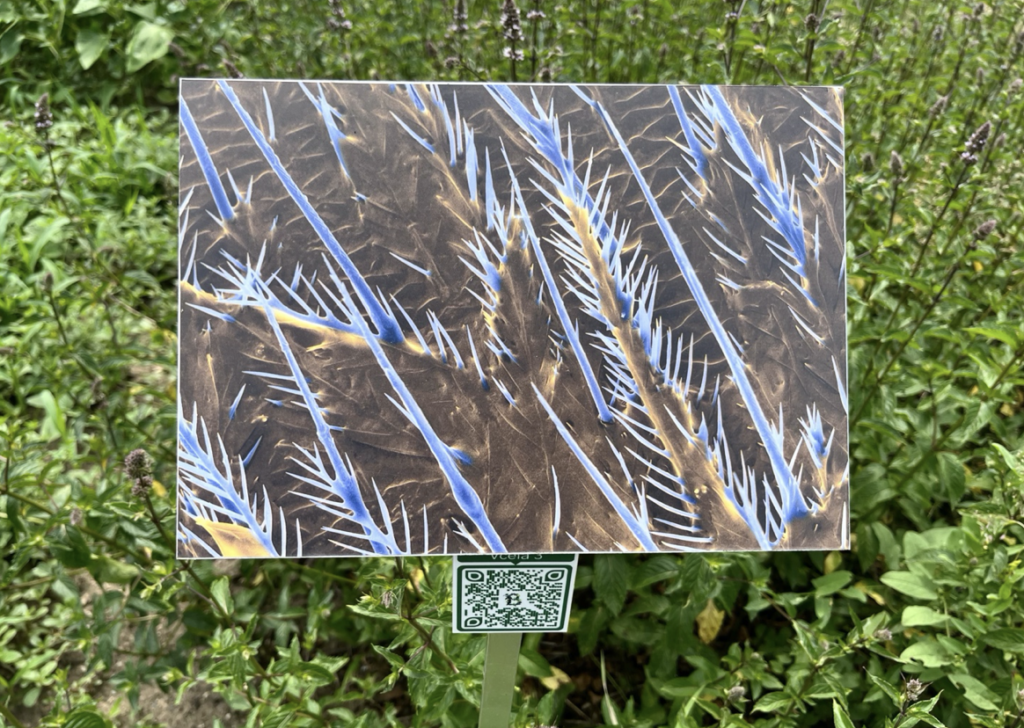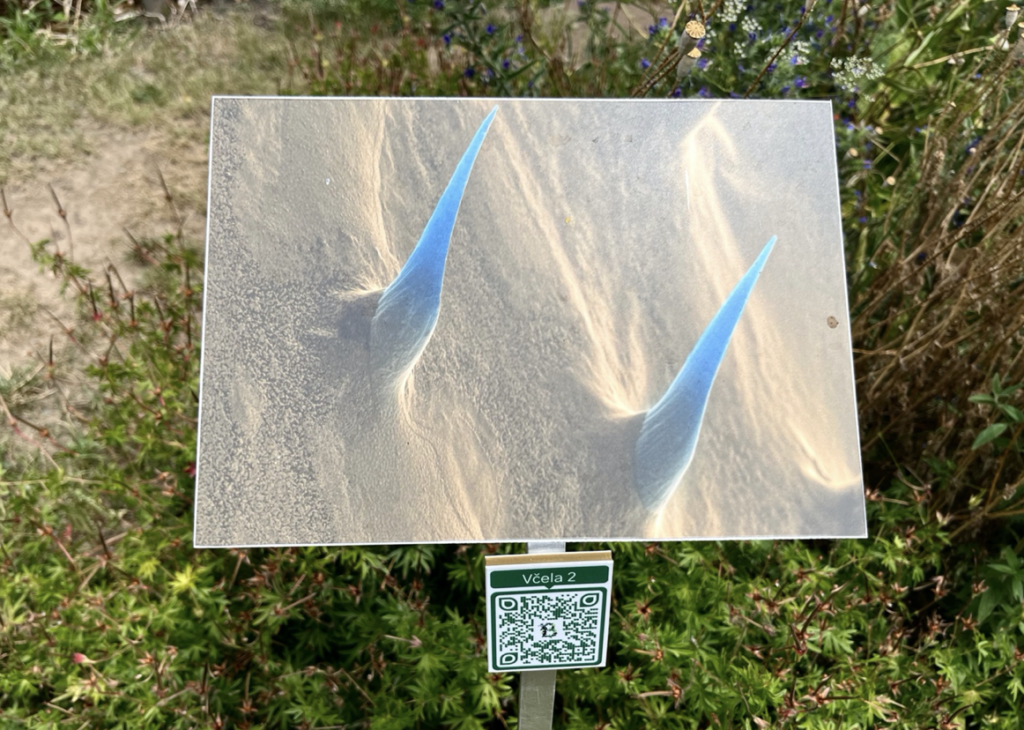Going on Assignment in Prague July 2024 – July 6, 2024
Prague Botanical Garden Uses Microscopic Photography to Feature Close-Up Photos of Honeybees
By Jessica Foshee
The Prague Botanical Garden is currently hosting the Queens of Honey Up Close exhibition, allowing visitors to learn more about honeybees by viewing photos of them from an extraordinary perspective with the help of close-up photography technology.
Scanning electron microscopy (SEM) is a photographic technique that can magnify photos up to 300,000 times their original sizes. “SEM is a tool at which invisible worlds of microspace and nanospace can be seen,” according to 2018 Hervex Conference proceedings by Azad Mohammed and Avin Abdullah from the Civil Engineering Department at the University of Sulaimani in Iraq.
 This display of Viktor Sýkora’s photos at the Queens of Honey Up Close exhibition includes a close-up of hair on the honeybee’s leg (middle) and close-up of pollen collected on the honeybee’s leg hair (right).
This display of Viktor Sýkora’s photos at the Queens of Honey Up Close exhibition includes a close-up of hair on the honeybee’s leg (middle) and close-up of pollen collected on the honeybee’s leg hair (right).
The microscopic photography technique allows viewers to observe honeybees in a way that most people likely have never experienced. Thanks to the work of Viktor Sýkora, researcher and head of the Center for Experimental Biomodels at Charles University in Prague, visitors of the exhibition have the opportunity to view honeybees on a microscopic level.
Visitors of the exhibition will appreciate the beauty of being surrounded by the diverse atmosphere of plants at the Prague Botanical Garden. As an added benefit, they will have the chance to witness honeybees in their natural habitat pollinating flowering plants that are essential to the ecosystem such as lavender, chamomile and salvia.
By scanning the QR codes accompanying Sýkora’s photos, visitors can enjoy an interactive experience at the exhibition. When scanned, the QR codes open a detailed description of the photo in a web browser, which tells visitors exactly what each microscopic photo shows.

Sýkora has specialized in scientific photography and photomicrography since 2006. “Photomicrographs,” which are photos taken using a microscope, “from both light and electron scanning microscopes, reveal details that our eyes cannot capture in real life. Thanks to modern technology, we can discover an unexpectedly beautiful and interesting invisible world,” said Sýkora on his website.
Microscopic photography brings an entire new, detailed perspective of honeybees to human eyes. Modern advances in technology like microscopic photography give viewers of the exhibition access to the hidden realm of the microworld to gain a better appreciation of the beauty of organisms like the honeybee.
“I had a wonderful time at the honeybee exhibition. It was a captivating experience for me, as I had never seen microscopic photos of bees before. The exhibition truly sparked my interest and was really fascinating,” said Anna, one of the visitors of the exhibition.

Researchers have discovered new things about honeybees with the help of microscopic photography technology. One example is a study by Alfred Dietz and Walter J. Humphreys from the Department of Entomology at the University of Georgia in Athens. The study discovered the presence of a sense organ on the flagella, a hairlike structure that allows microorganisms to travel in the cells of organisms, of honeybee antennae.
Microscopic photography also allows researchers and students of entomology, the study of insects and their relationships to the environment, to gain a better understanding of honeybees and their life cycles. Through photomicrography, entomologists can study the cells of honeybee eggs and can better understand the global trend of colony losses.
Honeybees play a vital role as pollinators, ensuring the reproduction of numerous essential crops that are part of the human diet. Their crucial function in pollination significantly impacts food production, making declining bee populations a matter of significant concern. The ecosystem’s balance, plant biodiversity and our daily food supply rely heavily on the important work carried out by honeybees.
“An estimated 70 percent of the world’s agriculture depends on bees. Bees provide pollination for plants that feed the majority of the human population,” said Sýkora in an interview.
The Queens of Honey Up Close exhibition, located in the HONEYcation Garden of the Prague Botanical Garden, is available to view from now until October 31.
 Education
Education